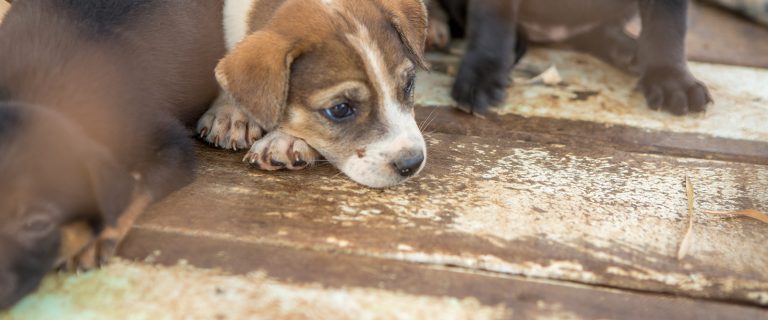Great Pyrenees dogs are one of those breeds that just seem to have it all. They’re protective but not prone to violence. They’re large, but their laid back personality makes them easy to handle. Above all, Great Pyrenees dogs are just bout bursting at the seams with love.
Related: Large Dog Breeds You’ll Fall in Love With
The Lowdown on Great Pyrenees Dogs
This is a breed that was fairly made for family living. It’s origins are of a livestock guardian, and that, coupled with its propensity for love and devotion, makes it an excellent furry family member.
Origin
The first mentions of Great Pyrenees dogs dates back to 1407. This old breed was a guard dog used by the Basque people to guard sheep in and around the Pyrenees Mountains of southern France and northern Spain. Because of the need for a dog that could fight off potential threats and also keep up with the sheep on the rocky slopes, the Great Pyrenees was bred to be both large and agile.
Temperament
Great Pyrenees dogs are loving to the extreme and as protective as it gets. They will vigilantly protect the family – especially the kids, whom they fawn over – from any real or perceived invaders such as mailmen, squirrels, leaves, shadows, etc. Although highly protective, this breed seems to have an innate ability to recognize what are true threats and what are not.
Although the breed has a natural mix of protectiveness and friendliness which makes it great for families, proper socialization is key to ensuring that its protective instincts don’t turn into something more serious like unwanted aggression or fear.
While Great Pyrenees dogs are protective and loving to the point of doting, they are also quite stubborn. This is not the breed for a first time dog owner. In fact, it’s a breed that requires time and dedication. They are huge, so they must listen to their masters.
Size
Great Pyrenees dogs are big. In fact, they can top out at around 160 pounds for the really big boys. That’s even bigger than the Newfies I talked about last time. That’s why training is key. With a dog as big as a Great Pyrenees, you need to be in control. With a dog this size, happiness can be just as dangerous as aggressiveness.
A side note on size is that although this dogs are big, big, big. They make great indoor pets. Sure they need exercise, but when they’re indoors, their laid back personality makes them extremely easy to live with and extremely easy to keep the furniture intact.
Energy Level
Although this breed needs to stay active, this isn’t a dog that’s going to destroy the house if it doesn’t get in a walk. Okay, maybe when it’s a puppy, but after that? No. For a breed designed to work, Great Pyrenees dogs are on the lazy side. They only need moderate amounts of exercise like a good walk or a game of fetch in the backyard. Otherwise, they’re content to loll around the house and veg.
Health
Great Pyrenees dogs are generally healthy, by an large being prone to what almost all large breed dogs are prone to. In addition, they are relatively long lived for a dog of their size, with a lifespan of up to 12 years.
Although the breed is more prone to the following, it doesn’t mean your dog will have any of these.
- Gastric Torsion – Also known as bloat. This is a condition in which the stomach expands due to rapid eating, drinking, panting, or a combination of those and then flips over on itself. It’s exceedingly painful and deadly if not treated immediately. Tacking the stomach to the abdominal wall during neutering or spaying is recommend to prevent torsion in case of bloat.
- Hip Dysplasia – A condition in which the head of the thigh bone doesn’t seat properly in the hip socket. Mild cases can be treated with medications to control pain and inflammation. More severe cases may require surgery.
- Elbow Dysplasio – Essentially the same condition as the above but occurring in the dog’s elbow.
- Addison’s Disease – A disease in which the adrenal glands don’t produce enough hormones, leading to improper levels of potassium and salt in the body. Symptoms include lethargy, vomiting, and inappetence.
- Cataracts – A clouding of the lens of the eye. Almost all dogs are prone to this as they reach their geriatric years.
- Entropion – A disorder which causes the eyelid to roll inward, which can irritate or injure the eyeball. It’s usually noticeable by 6 months of age. Watch for rubbing at the eyes. It is fully correctable with surgery.
Grooming
Great Pyrenees dogs were bred to live in the mountains, and as a result, they have a double coat which needs regular brushing. This helps keep the fur and dander down, and it also serves to keep your pooch looking its best. All other standard grooming points apply such as regular nail trimmings, weekly or bi-weekly baths, brushing the teeth, and ear cleaning.
Great Pyrenees Dogs – Great Dogs Period
If you have the patience to deal with a bit of a stubborn streak, Great Pyrenees dogs are one of the best breeds around. Although they can be slow on the uptake, once they are trained, they’re trained for life. When you couple that with their intensely loyal, protective, and loving nature and the fact that they are low energy for such a large dog, you’ve got a recipe for family dog success.
As always, make adoption your first option. Great Pyrenees dogs might now show up at your local shelter, but you can almost always find breed specific rescue sites online. There are so many dogs out there that need forever homes, you can probably find several Great Pyrenees dogs that could use a home, as well.
Do you have a Great Pyrenees? Tell us what you love about this large breed dog!
Author
-

A former Veterinary Assistant at Southwest Animal Care Hospital, Ben is an animal lover, blogger, and all-around geek. Along with writing for DogVills, Ben runs his own virtual assistant company, BizzyBim.
View all posts



